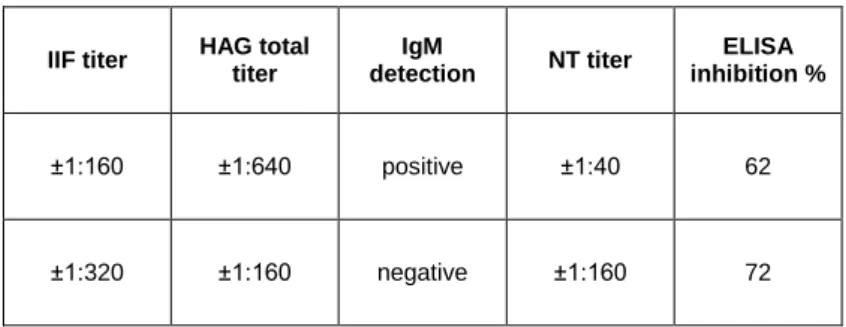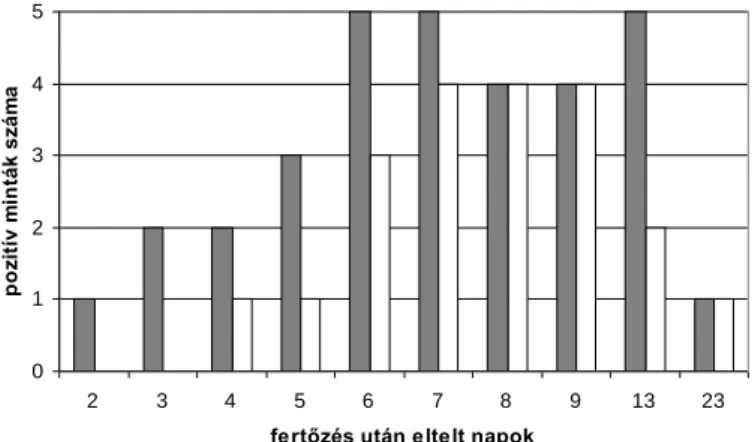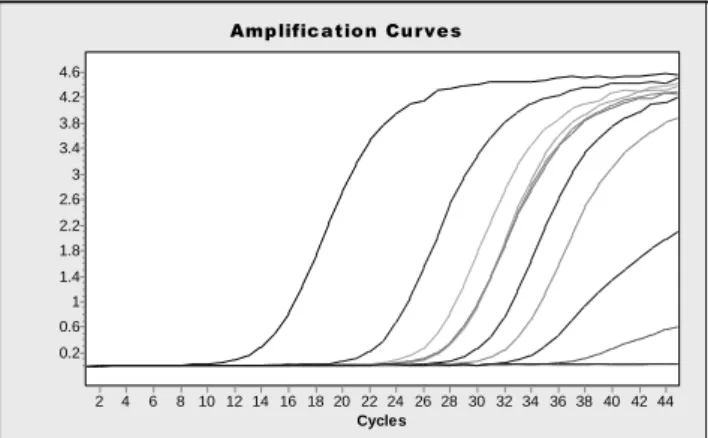Tick-borne encephalitis spread by raw goat milk
PhD Thesis booklet Zsuzsanna Balogh
Semmelweis University
Doctoral School of Pathological Sciences
Supervisor:
Dr. György Berencsi, Ph.D.
Official opponents:
Dr. Ágoston Ghidán, Ph.D.
Dr. Tamás Bakonyi, Ph.D.
Chairman of Theoretical Examination:
Dr. Károly Nagy, Ph. D.
Members of Theoretical Examination Panel:
Dr. Ferenc Rozgonyi, Ph.D., DSc Dr. Miklós Rusvai, Ph.D., DSc
Budapest
1. INTRODUCTION
Milk is often consumed raw among farm families, mostly because of taste and convenience, but there is also a small portion of the general population which drinks raw milk, since it is believed to prevent and treat certain diseases. Scientific evidence confirming the supposed beneficial effects of unpasteurized milk are scarce, however, there are numerous publications reporting about milk- borne infections. Raw milk and cheeses and other dairy products made of milk can be contaminated with various pathogens including different bacterial strains and the tick-borne encephalitis virus (TBEV) as well.
Since the 1950’s, the National Center for Epidemiology (NCE) is responsible for the laboratory diagnosis of tick-borne encephalitis. In many cases, the consumption of raw milk preceding the onset of the disease can be found in patient history. Milk-borne infections are usually family outbreaks limited to those people who consume the milk of the infected animal(s), but sometimes major outbreaks occur, when the infected milk is sold commercially. The latest raw milk-borne outbreak in Hungary was in August 2007.
Thirty-one people became ill after consumption of infected milk, 25 of them showing the specific symptoms of tick-borne encephalitis:
biphasic fever with neurological symptoms in the second phase.
Examination of patient samples is a daily routine at the NCE, however, due to epidemiological reasons in connection with zoonotic diseases, sometimes there is also a need for specific tests, which are usually not included in the profile of human diagnostics; they are rather at the border between human and animal public health. In
these special cases, the National Reference Laboratory for Viral Zoonoses at the NCE also does the examination of animal samples.
We examined the serum samples of the goats at the farm that was identified as the source of the 2007 outbreak and meanwhile, we took the opportunity to compare the sensitivity and specificity of the serological methods in use.
Due to the lack of recent experimental data on the course of TBEV infection in goats and on the spread of TBEV by milk, in the second part of our work we designed an experiment with 20 goats to study how long TBEV can be detected from goat milk, approximately how much virus is secreted, and how these parameters are affected when the animal is immunized before the infection.
Finally, we examined whether boiling is inevitably necessary to inactivate the infective virus in the milk.
2. OBJECTIVES
2.1. Investigation of the Lakhegy outbreak: examination of human and goat samples (cerebrospinal fluid and/or serum)
Laboratory confirmation of human TBE cases of goat milk origin
Detection of specific anti-TBEV IgG and IgM from the blood of the goats from the farm that caused the Lakhegy outbreak using routine diagnostic methods (indirect IF, hemagglutination inhibition, virus neutralization)
Examination of the samples using an ELISA developed by the Polish colleagues and comparison of results with those of the routine methods
2.2. Examination of the TBEV infection of goats
Statistical analysis of body temperatures of experimentally TBEV-infected goats and confirmation of the infection taking place without fever
Description of the duration of TBEV shedding with milk
Examination of the amount of the virus shed with milk
To investigate whether shedding of virus with milk can be prevented by immunizing goats with human vaccine
2.3. Investigation of the possibilities of heat treatment of infectious goat milk
Examination of the infectivity of TBEV-containing goat milk following incubation at room temperature
Examination of the infectivity of TBEV-containing goat milk following heat treatment (heating, boiling)
3. MATERIALS AND METHODS
Human blood and cerebrospinal fluid samples. We examined the blood samples of 31 patients who had drunk raw goat milk and were supposed to be infected with TBE virus. The samples were collected between the 1st and 25th day after the onset of the symptoms. In case of three patients cerebrospinal fluid samples were also available. We had blood samples from 8 people who drank of the infected milk but remained symptomless.
Goat blood samples from the Lakhegy farm. We received blood samples from all of the goats (73 females and 2 males) at the farm identified as the source of infection. The animals were 2-8 years old.
Goat blood and milk samples from the animal experiment. We collected blood from the immunized goats to determine whether they became protected. We milked the 10 TBEV-infected goats for 9 days after infection and again on the 13th and the 23rd day.
For indirect immunofluorescence we used in-house prepared slides.
After the initial dilution of 1:5, a twofold dilution series was prepared of each serum sample. Of each dilution, a drop was placed on the test slides, which were incubated overnight at +4°C, then probed with fluorescein isothiocyanate conjugated antibodies for 30 min at 37°C.
Hemagglutination inhibition was carried out using a modified Takátsy micromethod. Aspecific inhibitors and hemagglutinins were removed from the samples with acetone or kaolin and goose erythrocytes, respectively. The total IgM and IgG antibody content of sera was measured using goose erythrocytes and TBE virus
prepared in-house. In order to measure IgM, sera were fractionated and the IgM rich fraction was treated with 2-mercaptoethanol.
Microneutralisation test (goat blood samples). 100 TCID50 virus was incubated on Vero cells with each dilution in a serum dilution series and after 5 days, the cytopathic effect was evaluated by microscopy.
ELISA (goat blood samples). Samples were tested using the FSME ELISA IgG test adapted for competition blocking (blocking the reactivity of human serum by goat antibodies) at the Polish National Institute of Hygiene.
Nucleic acid extraction. Viral RNA was extracted with the QIAamp Viral RNA Mini Kit according to the manufacturer’s instructions.
RT-PCR methods. For reverse transcription, reagents of the GeneAmp RNA PCR kit were used. For nested PCR assay, primers targeting the NS5 region of the virus genome were used with GeneAmp reagents, whereas for one-step quantitative RT-PCR we used the SuperScript™ III Platinum® One-Step Quantitative RT- PCR System kit. Details on the PCR reactions can be found in Balogh et al. (2011).
Heat treatment of milk samples. Heat treatment at 65°C was performed using a water bath, for 100°C heat treatment, tubes were immersed in boiling water.
Statistical analysis. Body temperature data of goats were analysed with the Minitab® 15.1.1.0. software (Minitab Inc., State College, Pennsylvania). A two-factor ANOVA analysis of variances was performed with p<0,05.
4. RESULTS
4.1. Investigation of the milk-borne TBEV outbreak of Lakhegy Twenty-five of the 39 human serum samples proved to be positive for anti-TBEV antibodies – both IgG and IgM – in IIF tests and also in confirmatory HI assays. For these 25 patients, acute TBEV infection was confirmed. Sera of six patients tested negative for anti-TBEV antibodies, which together with the clinical picture, allowed the exclusion of TBE in these cases.
Besides confirming clinical diagnoses, we aimed to identify those goats that previously or currently had a TBEV infection and thus could shed the virus with their milk. We collected blood samples from the 75 goats on the farm and examined them with different serological methods: indirect immunofluorescence (IIF), hemagglutination inhibition (HI), microneutralisation (NT) and ELISA. The four methods probed to be different in specificity. The least specific was the IIF assay. Comparison of the results of the other three methods revealed that two goat sera were positive for anti-TBEV IgG and one for anti-TBEV IgM (Table 1).
Table 1. Serological results of the two goats evaluated as positives with different methods.
IIF titer HAG total titer
IgM
detection NT titer ELISA inhibition %
±1:160 ±1:640 positive ±1:40 62
±1:320 ±1:160 negative ±1:160 72
4.2. Experimental infection of goats
Ten goats (5 of which were immunized previously) were infected with TBE virus and ten were observed as controls (5 immunized and 5 naïve). The health state and body temperature of the animals was recorded and milk samples were collected daily.
Viral RNA and infective virus particles were detected from the milk by RT-CR and intra-cerebral inoculation of suckling mice, respectively.
During the experiment, the infected animals showed no symptoms and according to the statistical analysis, their body temperature did not differ from that of the the controls either.
Infective virions were detectable from the milk samples of the infected goats for 8-19 days, virus genome was detected by PCR for 3-18 days (Figure 1). The immunized goats did not shed the virus.
0 1 2 3 4 5
2 3 4 5 6 7 8 9 13 23
fertőzés után eltelt napok
pozitív minták száma
Figure 1. Milk samples of five TBEV-infected goats. Grey: positive for TBEV by inoculation to suckling mice. White: positive for TBEV by specific RT-PCR. (23rd day: only 4 samples available)
4.3. Comparison of the virus content of the milk samples
Based on the results of virus detection, the milk samples of the 6th and 7th days were chosen for measuring viral load by real-time RT-PCR. The titers were compared to a standard series consisting of four dilutions of a TBEV suspension. The virus content of the samples from the 6th day was rather varied, samples from the 7th day were more similar. The highest virus content was measured in the 6th day sample of goat No. 76967 (Figure 2), corresponding in order of magnitude to the 1:10 dilution of the infected suckling mouse brain suspension used as standard. The milk of this animal was used in heat treatment experiments as a sample containing a larger amount of virus.
Amplification Curves
Cycles
44 42 40 38 36 34 32 30 28 26 24 22 20 18 16 14 12 10 8 6 4 2
Fluorescence (530/705)
4.6 4.2 3.8 3.4 3 2.6 2.2 1.8 1.4 1 0.6 0.2
Figure 2. Amplification curves of milk samples from the 6th and 7th day after infection. The fluorescent signal rising the earliest is the 6th day sample of goat No. 76967.
4.4. Investigation of the effect of heat treatment
The effect of heat treatment was examined using the milk
whereas the other had less. To mimic household practices, three temperatures were chosen: incubation at room temperature, at 65°C to simulate heating but not boiling, and at 100°C as for boiling.
Incubation at room temperature did not prevent the lethal infection of suckling mice when inoculated with either of the milk pools, although after a longer incubation time the symptoms appeared somewhat later. The milk pool with the larger amount of virus was still infective after 30 min incubation at 65°C, however, boiling the milk was effective for both pools, following inoculation, the mice showed no symptoms of the infection until the end of the experiment.
5. CONCLUSIONS
5.1. Investigation of the Lakhegy outbreak: examination of human and goat samples (cerebrospinal fluid and/or serum)
The TBEV shed with goat milk is concentrated enough to be able to infect humans, even when it is diluted, since only a few of 69 animals were confirmed to have had a TBE infection, but their milk was able to infect even when mixed with the milk of the others.
Goat blood samples should be examined with different routine diagnostic methods. Besides IIF assay, HI and/or virus neutralization is needed to help recognize aspecific reactions.
The ELISA developed by the Polish colleagues is precise, speci- fic and reliable when used with goat samples, therefore, it is recom- mended to use it as a confirmatory test in case of unclear results.
In TBEV endemic regions, the people should be informed not only about the risks of a tick-bite but also about the dangers of consuming raw milk.
5.2. Investigation of the TBEV infection of goats
Comparing the body temperatures of goats experimentally infected with TBEV and that of control animals, it can be confirmed statistically that TBEV infection does not cause a rise in temperature in goats.
There can be great individual differences in the duration virus shedding and in the amount of virus shed with milk.
Virus shedding with milk can be prevented efficiently by immunizing goats, even using human vaccine.
5.3. Investigation of the possibilities of heat treatment of infectious goat milk
When incubated at room temperature, goat milk containing TBEV retains its infectivity even after 2 days.
Incubation at 65°C does not inactivate safely the TBEV present in goat milk, if there is a large amount of virus.
Boiling for 3 min is sufficient to inactivate TBEV in goat milk.
6. OWN PUBLICATIONS
The thesis is based on the following publications:
1. Balogh Z, Ferenczi E, Széles K, Stefanoff P, Gut W, Szomor KN, Takács M, Berencsi G: Tick-borne encephalitis outbreak in Hungary due to consumption of raw goat milk. J Virol Met. 2010;163:481-
2. Balogh Z, Egyed L, Ferenczi E, Bán E, Szomor K N, Takács M, Berencsi G: Experimental infection of goats with tick-borne ence- phalitis virus and the possibilities to prevent virus transmission by raw goat milk. Intervirology 2011 Feb 12. [DOI: 10.1159/
000324023].
Other publications:
1. Szomor KN, Rigó Z, Bán E, Nagy L, Szalkai T, Balogh Z, Ferenczi E, Takács M: Serologic evidence of West Nile virus infection in patients with exanthema in Hungary. Acta Microbiol Immunol Hung 2011;58:157-167.
2. Takács M, Balog K, Tóth G, Balogh Z, Szomor KN, Brojnás J, Rusvai E, Minárovits J, Berencsi G: TT virus in Hungary: sequence heterogeneity and mixed infections. FEMS Immunology and Medical Microbiology 2003;35:153-157.
Book chapters:
1. Balogh Zs.: Tenyésztés állatokban. (in: Tenyésztésen alapuló módszerek, Klinikai és Járványügyi Virológia. Főszerkesztő: Takács Mária.) Melánia Kiadó Kft., Budapest, 2011.
2. Balogh Zs., Rózsa M: Immunfluoreszcencián alapuló módszerek.
(in: Klinikai és Járványügyi Virológia. Főszerkesztő: Takács Mária.) Melánia Kiadó Kft., Budapest, 2011.
3. Balogh Zs., Bán E.: Filoviridae. (in: Klinikai és Járványügyi Virológia. Főszerkesztő: Takács Mária.) Melánia Kiadó Kft., Buda- pest, 2011.
Presentations, posters:
Presentations and posters abroad
1. Balogh Z: Infection through goat milk in Hungary. 12th ISW- TBE Annual meeting, 2010, Vienna, Austria, invited speaker.
2. Balogh Z, Ferenczi E, Egyed L, Szomor KN, Takács M, Berencsi G: Tick-borne encephalitis caused by unpasteurized milk in Hungary. EDEN Annual Meeting 2010, Montpellier, France.
3. Ferenczi E, Széles K, Balogh Z, Gut W: Tick-borne encephalitis outbreaks through raw milk consumption in Hungary. MedVetNet Annual Meeting, 2008, Saint Malo, France.
4. Balogh Z, Széles K, Ferenczi E: Alimentary TBEV outbreaks in Hungary. EDEN Annual Meeting 2008, Brno, Czech Republic.
Presentations and posters in Hungary
1. Ferenczi E, Széles K, Balogh Z, Gut W: Tick-borne encephalitis outbreaks through raw milk consumption in Hungary. International Congress of Veterinary Virology 2009, Budapest.
2. Balogh Z, Ferenczi E, Széles K, Gut W, Berencsi G: Nyers tej fogyasztásával terjedő kullancsencephalitis járványok Magyarorszá- gon. Annual Meeting of the Hungarian Society for Microbiology 2008, Keszthely.
3. Balogh Z: Rövid áttekintés a Magyarországon felbukkanó, új fer- tőző kórokról. Symposium of the Chiron company and the Hungarian Haemophilia Society, 2008, Szeged, invited speaker.
4. Balogh Z, Takács M: A TT vírus előfordulása a magyar lakosság körében. Annual Meeting of the Hungarian Society for Microbiology 2001, Balatonfüred.


